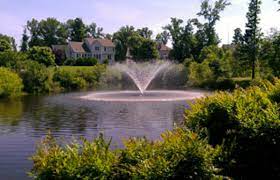Finding The Right Pond Aeration System For Your Needs
One of the more frequent questions asked by our customers is, “Which aeration system is best for my pond – a subsurface aerator or a fountain surface aerator?” The answer is simple: Both are great sources of aeration for ponds or lakes of any size, but there are differences between the two.

When a customer poses this question, we ideally like to visit the pond. On our first site visit, we will measure the surface area and depth of the pond or lake to determine the proper size of submersed or fountain aeration system that will best suit the pond. The shape of the pond, water quality, and water source is also a large factor in determining our recommendations. Our main priority is to match the right system to each customer’s personal goals and also stay within the customer’s budget.
Floating fountain aerators offer both the aeration and an aesthetic quality that many customers desire. The potential downside of fountain aeration is that the aeration is generally localized and works great for ponds that are shallow and symmetrical in shape like oval, square, triangular, or round. They work by taking in water from the upper few feet of water column and throwing it into the air, where it picks up oxygen. The induced circulation this causes creates a cycle of returning oxygenated water to the pond. Irregular shaped ponds can benefit from just fountain aeration, but more units would be needed to achieve uniform aeration for the whole pond, with a potentially higher cost to the customer.

Submersed Aeration Systems, or bottom diffused systems, release oxygen directly into the water column at precise locations within the pond. These systems can supply aeration for any pond but work extremely well for deeper or irregular shaped ponds such as kidney shaped or long and narrow ponds. In irregular shaped ponds, fountain surface aerators are generally limited because they are placed centrally in an effort to cover the most surface; however, this creates dead zones in the odd shaped areas of the pond. In these situations, surface aerators will almost always have to be supplemented with submersed aeration to achieve the ideal aeration for the pond. Using all submersed aeration systems in irregular shaped ponds will create the best overall aeration and will, in most cases, cost the customer less than surface aeration.
Basically, aerator placement is the most crucial piece to this puzzle. If the pond is round, placing a fountain aerator (in the center) large enough to aerate the pond would be fine. It would create a nice spray pattern display plus the proper aeration for the pond; but, if the pond is irregular in shape, then specific placement of submersed bottom diffusers would be the best option so as to target the entire body of water.
The best option for dealing with ponds of irregular shapes, where the community wants the aesthetic look of a fountain, but needs to aerate parts of the pond that a fountain may not reach, is to install a fountain nearest to the center of the pond and add diffused aeration to the outlying areas of the pond.
Whichever option suits your community and your budget, a pond aeration system can be a big investment for your community, but it will protect a bigger investment by ensuring a long and healthy life for your pond.
Contact SOLitude Lake Management to speak with an expert biologist, ecologist or scientist for all of your lake, pond and fisheries management needs. 888-480-5253 or [email protected]. Services available in VA, NC, SC, MD, PA, DE, WV, NJ & NY. Aquatic products and consultation are available nationwide.









